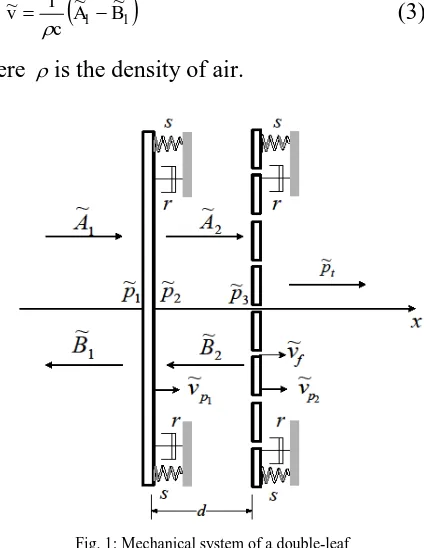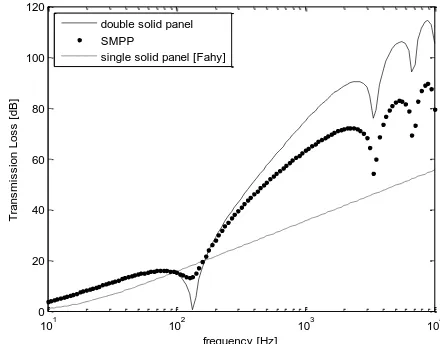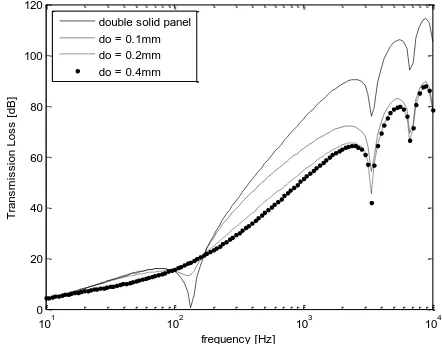Hari Penyelidikan 2011, Fakulti Kejuruteraan Mekanikal, Universiti Teknikal Malaysia Melaka, 20 Julai 2011
46
Application of Micro-perforated Panel (MPP) in a Vehicle Vabin:
Overcoming t
he ‘Mass
-Air-
Mass’ R
esonance
Ahmad Yusuf Ismail1, Azma Putra2, Md. Razali Ayob3
Abstract– One of the most considerable aspects of a vehicle design judged by the customers is the noise level inside the cabin. The conventional method is the use of absorbent materials as the noise absorber e.g. foam and other porous materials. These materials are usually made from synthetic and are therefore not environmentally friendly. Moreover, they can be easily dirty or damage and give bad odour due to smoke or moist. Since the microperforated panel (MPP) has been investigated to have a good performance as the sound absorber, there is a feasibility to implement such a panel inside a vehicle cabin. The MPP which is constructed from a solid panel will provide a hygienic and a non-abrasive material. Its optically attractive surface will also enhance the art in the cabin interior. This paper is the preliminary study to investigate the performance of a double-leaf solid and microperforated partition (SMPP) in terms of its sound transmission loss (STL). The mathematical model for the STL is derived. The result shows that the performance substantially improves at the troublesome frequency the so-called mass-air-mass resonance which occurs in the conventional double-leaf partition. This is important particularly for the noise source predominant at low frequencies. This can also be controlled by tuning the hole size and number as well as the air gap between the panels.
Keywords: Sound transmission loss, double-leaf, partition, micro-perforated panel
I. Introduction
Low noise level inside a vehicle cabin, such as car, train and airplane is important to provide
a ‟comfort room‟ for the passengers. Hence, the design of the structural car body such as the door, roof and cabin interior is made such that noise from engines, tires or wheel, brake, road or turbulence boundary layer is transmitted into the cabin with minimum amount. A well known method for reducing noise is by installing a partition panel. In general, the partition has a main function to reflect most of the noise and transmit the rest. This is caused by large changes of acoustic impedance in the transmission path created by the partition [1]. A double-leaf partition is known as the lightweight structures in a vehicle such as car doors, train walls or aircraft fuselages. This double-panel is found to increase the transmission loss significantly compared with
the single panel partition [1]. However, for noise source predominantly dominates at low frequencies, a double-partition will give a poor performance due to the so-called mass-air-mass resonance.
Several works have been done to improve the performance of the double-leaf partition including to overcome the problem at mass-air-mass resonance, i.e. by placing a Hemholtz resonator between the gap [2], embedding long T-shaped resonators along the edge of the double panel partition [3], placing loudspeaker and installing actuator between the gap to actively control the acoustic mode [4] or filling the absorbent material inside the gap [5].
Hari Penyelidikan 2011, Fakulti Kejuruteraan Mekanikal, Universiti Teknikal Malaysia Melaka, 20 Julai 2011
47
Fig. 1: Mechanical system of a double-leaf solid-microperforated partition
panel will provide a hygienic and a non-abrasive structure. Its optically attractive surface will also enhance the art in the cabin interior.
Dah Yu Maa proposed a micro-perforated panel (MPP) to substitute the conventional fibrous sound absorber materials. MPP is a perforated panel with milimetric size holes backed by air cavity and rigid surface. The holes diameter must be in the range between 0.05-1 mm and the perforation ratio is between 0.5-1.5% [6]. Many works have also been done to gain a better performance of MPP in terms of its absorption including by coupling it into a double-leaf system [7], increasing the thickness to obtain better mechanical structure properties [8], modifying the hole shape [9] and partitioning the back cavity [10].
However, to be a noise barrier the presence of holes will reduce the transmission loss performance which cannot be tolerated. This paper is the preliminary study to investigate the performance of a double-leaf solid and micro-perforated partition (SMPP) in terms of its sound transmission loss (TL). In the next section, the mathematical model for the TL is derived.
II. Mathematical Formulation
Fig.1 shows a mechanical system of a SMPP with uniform, unbounded and non-flexible panels having mass per unit area supported by viscous dampers r and elastic suspensions s impining by normal incidence of sound wave. The incident and reflected sound pressure with frequency at the solid panel are given by
jkx
i Ae
p ~1
~ (1)
jkx
r Be
p ~1
~ (2)
where k/cis the acoustic wave number and
c is the speed of sound.
Using Euler equation
x p j
v x
1
~ at x = 0
-for (1) and (2), the particle velocity can be written as
1 1
~ ~ 1
~ A B
c v
(3)
where is the density of air.
Since the first panel is solid, the particle velocity along the plate surface is same with panel velocity . Equation (3) can be rearranged as
1 1
~ ~ ~
1 A B v
zf p (4)
where zf c is the impedance of the air. The acoustic pressure acting on the solid panel surface p1and p2 at x = 0 and on the perforated
panel surface at x = d are given by
r
i p
p B A
p ~ ~ ~ ~
~
1 1
1 (5)
2 2 2
~ ~
~ A B
p (6)
jkd jkd
e B e
A
p3 ~2 ~2
~ (7)
v z pt f
~ (8)
Hari Penyelidikan 2011, Fakulti Kejuruteraan Mekanikal, Universiti Teknikal Malaysia Melaka,
and is the perforation ratio. The impedance of the holes Zo Zo,RZo,I is given by Maa [6] holes. The following equation of the net force acting on the plate can then be expressed [14]
v v
Z v p Zo,R ~f ~p o,I~f 2 (12)
Re-arrange (12) and substitute to (9) gives the mean particle velocity as a function of the pressure difference p
Z due to the acoustic loading is given by
2
where the second term on the right hand side of (14) is the viscous force inside the hole.
Re-arrange (14) and using (12) yields
2 to the perforations given by
Equation (7) can be expanded into
A B
kd j
A B
kd caused by pressure difference acting on it is2 (right side surface of the solid panel)
The pressure difference at the perforated panel is
Hari Penyelidikan 2011, Fakulti Kejuruteraan Mekanikal, Universiti Teknikal Malaysia Melaka, 20 Julai 2011
49
Fig. 2: Sound transmission loss of single, double panel and SMPP under normal incidence of acoustic loading
101 102 103 104
double solid panel SMPP
single solid panel [Fahy]
Again substituting (13) into (22) and then to (15) gives the ratio of the panel velocity
Substituting (5), (19) and (24) into (18) yields the incident pressure
incident pressure and the transmitted pressure
Substituting the velocity ratio from (23)
and the transmission loss is
III. Mathematical Results
Fig.2 shows the theoretical results of sound transmission loss of conventional double-leaf partition (DL) and SMPP. The calculation is made for 1 mm thick steel plate with density 7800 kg/m3. The distance between the two panels is 50 mm. The material properties of the MPP as the rear panel is the same, with hole double-leaf across the frequency range except at the resonance. At this particular frequencies, both the panels and air inside the cavity move
in phase which is then known as „mass
-air-mass‟ resonance. The transmission loss is found drop to almost 0 dB which is a bad performance for a noise barrier especially for a noise source dominating around this frequency. The dips around 3.5 and 7 kHz are the cavity resonances which occur at the corresponding acoustic wavelength of n = 2d with n is any non-zero positive integer.
Hari Penyelidikan 2011, Fakulti Kejuruteraan Mekanikal, Universiti Teknikal Malaysia Melaka, 20 Julai 2011
50
Fig. 3: Sound transmission loss of SMPP with different hole diameters for 0.5% perforation ratio under normal incidence of acoustic loading
101 102 103 104
0 20 40 60 80 100 120
frequency [Hz]
Tr
a
n
s
m
is
s
io
n
L
o
s
s
[
d
B
]
double solid panel do = 0.1mm do = 0.2mm do = 0.4mm
Fig. 4: Sound transmission loss of SMPP with different perforation ratio for 0.1 mm hole diameter under normal incidence of acoustic loading
101 102 103 104
0 20 40 60 80 100 120
frequency [Hz]
Tr
a
n
s
m
is
s
io
n
L
o
s
s
[
d
B
]
double solid panel 0.5% 1.0% 1.5%
Fig. 5: Insertion loss of SMPP for different hole diameter for 0.5% perforation ratio
101 102 103 104
-40 -30 -20 -10 0 10 20
frequency [Hz]
In
s
e
rt
io
n
L
o
s
s
[
d
B
]
do=0.1mm do=0.2mm do=0.4mm
Fig. 6: Insertion loss of SMPP for different perforation ratios for 0.1 mm hole diameter.
101 102 103 104
-60 -50 -40 -30 -20 -10 0 10 20
frequency [Hz]
In
s
e
rt
io
n
L
o
s
s
[
d
B
]
0.5% 1.0% 1.5%
the air and the wall inside the holes. This friction force which has opposite direction to the motion of the panel gives additional damping to the cavity that reduces the coupling between the structural and the acoustic cavity modes. However, above this resonance, the TL from SMPP is lower than that from the DL.
Fig. 3 plots the results for SMPP with different hole diameter with constant perforation ratio 0.5%. The double panels DL decrease the TL by roughly 15 dB in average around the resonance. However, it can be seen that the use of a MPP for the second panel improves the TL around the resonance frequency. The improvement can be achieved by increasing the hole size, but in consequence, decreases the performance above the resonance.
Fig. 4 plots the results for constant hole diameter. The improvement of TL around the mass-air-mass resonance can also be seen by increasing the perforation ratio.
For clarity of analysis, the level of improvement or decrement of the TL can be represented by the insertion loss, i.e. the ratio of the transmitted power before to after the MPP is coupled which is given by
d s d s
TL TL
IL
10log (35)
where TLs is the transmission loss of the SMPP
and TLd is for the double solid panels (DL).
Hari Penyelidikan 2011, Fakulti Kejuruteraan Mekanikal, Universiti Teknikal Malaysia Melaka, 20 Julai 2011
51 can be seen to increase with frequency.
Fig. 6 shows the insertion loss for different perforation ratios. Same with previous results, the improvement can be seen by 15 dB only around mass-air-mass resonance.
IV. Conclusion
In order to improve the poor performance of transmission loss of conventional double-leaf partition, the presence of microperforated holes in the second panel is found to be effective. However, the improvement only happens at a very narrow frequency band around the mass-air-mass resonance. It is found that this improvement can be increased by increasing the hole size or the perforation ratio. On the other hand, application of the MPP seems to sacrifice the performance at high frequencies. Nevertheless, this is beneficial especially for the noise source dominating at low frequencies. Moreover, the model proposed assumes normal incidence of sound excitation. For more real application, which is diffuse field, the effect will be larger in terms of the frequency range. This will be investigated on the future work.
Acknowledgements
This research is funded by The Fundamental Research Grant Scheme (FRGS) of the Ministry of Higher Education (MOHE) Malaysia in Universiti Teknikal Malaysia Melaka.
References
[1] Fahy, F., “sound and structural vibration : Radiation, Transmission and nresponse.” Academic Press, 2007.
[2] Mao, Q., Pietrzko, S., “Control of sound transmission through double wall partition using optimally tuned Hemholtz resonators” Applied Acoustics, 2005.
[3] Li, D., Zhang, X., Cheng, L., nad Yu, G., “Effectiveness of T -shaped acoustic resonators in low frequency sound transmission control of a finite double-panel partition.” Journal of Sound and Vibration, vol:329, pp. 4740-4755, 2010.
[4] Li and Cheng, “Mechanism oof active control of sound transmission through a linked double wall system into an acoustic cavity,” Applied Acoustics, vol : 69, pp. 614-623, 2008. [5] Alba, J., Ramez, J., and Snachez, V., “Improvement of the
prediction of transmission loss of double panel with cavity absorption by minimization techniques” Journal of Sound and Vibration, vol:273, pp.793-804, 2004.
[6] Maa, D., “Theory and design of microperforated panel sound absorbing construction (in chinese).” Scientica Sinica, vol:18, pp.55-71, 1975.
[7] Sakagami, K., Morimoto, M., and Koike, W., ”A numerical study of double leaf microperforated panel absorber.” Applied Acoustics, vol:67, pp.609-619, 2006.
[8] Pfretzschner, J. and Cobo, P., “Microperfoated insertion units : An alternative strategy to design microperforated panels.” Applied Acoustics, vol:67, pp.62-73, 2006.
[9] Sakagami, K., Morimoto, M., Yairi, M., and Minemure, A., “A pilot study on improving the absorptivity of a thick micoperforated panel absorber,” Applied Acoustics, vol:60, pp.179-182, 2008.
[10] Liu and Herrin, “Enhancing microperforated panel attenuation by partitioning the adjoining cavity,” Applied Acoustics, vol:71, pp.120-127. 2010.
[11] Takahashi, D., and Tanaka, M., “Flexural vibration of perforated plates and porous elastic materials under acoustic loading,” Acoustical Society of America, vol:112, pp.1456-1464, 2002.
1Acoustic and Vibration Research Group, Faculty of Mechanical
Engineering, Universiti Teknikal Malaysia Melaka, Malaysia.
2Acoustic and Vibration Reseacrh Group, Faculty of Mechanical
Engineering, Universiti Teknikal Malaysia Melaka, Malaysia
3Faculty of Mechanical Engineering, Universiti Teknikal Malaysia
Melaka, Malaysia.
Md. Razali Ayob received his Ph.D degree
in United Kingdom . His current interest includes air-conditioning and refirigeration, combustion and fuel engineering and building energy. He is currently the Dean of the Faculty of Mechanical Engineering, UTeM.
Ahmad Yusuf Ismail received his Bachelor
of Mechanical Engineering degree (2008) from Institute Technology of Sepuluh Nopember (ITS) Surabaya, Indonesia. His current research is in Noise and Vibration field. Ahmad Yusuf is now a postgraduate student at Universiti Teknikal Malaysia Melaka (UTeM).
Azma Putra is a senior lecturer in Faculty of
Mechanical Engineering, UTeM. He received his Ph.D in 2008 from Institute of Sound and Vibration Research (ISVR), University of Southampton, United Kingdom. His current interests are engineering acoustics and noise control, vibro-acoutics, vibration and structural dynamics.


